CLASSIC HORROR BEHIND THE SCENES: WOLF MAN ROARS AGAIN IN REBOOT
Filmmaker Leigh Whannell has a new take on the Classic Horror story. Is it worth seeing?
By Bill Fleck, author of the Rondo-nominated book CHANEY’S BABY, available here, and the recently released CHANEY’S AUDITION, available here.
Did you know? Two-time Rondo-Award winning filmmaker Thomas Hamilton is in the process of making VINCENT PRICE & THE ART OF LIVING. (I’m lucky enough to be a producer on the project.) Check out Tom’s latest HORROR ICONS update here. For information about possibly joining the Ignition Group and helping to get HORROR ICONS produced, click here. Thanks!
Check out other articles on this Rondo-nominated blog by clicking here.
NOTE: SPOILERS AHEAD! If you haven’t seen WOLF MAN yet, be warned…
Regular readers of this blog know how much I love the Wolf Man. It started when I was in third grade, and saw ABBOTT AND COSTELLO MEET FRANKENSTEIN (1948)—the gateway drug to the Universal Monsters! I thought it was noble of Lawrence Talbot to be tracking down Dracula and Frankenstein’s Monster, even though he himself “suffered the tortures of the damned” and killed people. [1]
In fact, Rondo-winning filmmaker Thomas Hamilton believes it’s a shame that Universal didn’t pick up the crusading Talbot character for a series of monster-hunter pictures, and I concur. Talbot as some sort of prototype Buffy? That would have been interesting for sure.
(Also interesting is the driving obsession The Wolfman—as he’s billed in A&C MEET FRANK—has with taking out Dracula…an obsession that may have inspired the vampire-vs.-werewolf wars in the UNDERWORLD series.)
By the time I’d seen all five of the Universal horror flicks with the Wolf Man as a character, I was convinced that no cinematic werewolf could match Lon Chaney, Jr. And in my 13-year-old zeal, I found reasons to judge—and discount—well, everyone else.
Henry Hull in WEREWOLF OF LONDON (1935)? Not hairy enough. And he talks at the end! Chaney didn’t do that.
Oliver Reed in CURSE OF THE WEREWOLF (1961)? He wears boots! Chaney didn’t do that. No transformed werewolf should be wearing boots!
And don’t get me started on Eric Braeden in the Kolchak episode THE WEREWOLF (1974). Or Bradford Dillman in MOON OF THE WOLF (1972).
[Above: Writer-director Leigh Whannell’s reboot of WOLF MAN features the Lovell family in isolation…and in danger. As we’ll see, Whannell and his wife—co-screenwriter Corbett Tuck—took their inspiration from the COVID pandemic.]
Well, that was then. This is now.
Maturity—or, what passes for maturity in my case—has softened and altered these opinions. I now truly appreciate what was accomplished in WEREWOLF OF LONDON, which established many of the things we associate with werewolves, including the full moon. And though I don’t think Wilfred Glendon is a sympathetic character as written, I appreciate Hull’s portrayal.
(I’d also like to note that Hull unfairly takes knocks over the years for “refusing to wear Jack Pierce’s original makeup design.” According to Cortlandt Hull, great nephew of Henry, the actor requested a lesser makeup because the script called for hero Paul Ames to recognize him in wolf form.)
And as to Oliver Reed? That guy was great in anything I’ve ever seen him in, which includes CURSE OF THE WEREWOLF, his first starring role. Plus, Roy Ashton’s makeup job is a knockout, boots and all.
Braeden and Dillman? Well, nothing’s really changed my early opinion in either case. But I’ve certainly appreciated other on-screen werewolves, particularly those huge beasts in UNDERWORLD (2003). (And, yeah…Kate Beckinsale helps.)
I’ve also been entertained along the way by Jack Nicholson in WOLF (1994), learned to appreciate Matt Willis’s talking Andreas in RETURN OF THE VAMPIRE (1943), and got some laughs out of Will Kemp in 2004’s VAN HELSING (again, Beckinsale helps).
[Above: Jack Nicholson in WOLF (1994). Werewolf designs on the screen have waxed and waned over the years. Like WOLF, the current WOLF MAN sports a more minimalist look, at least in terms of fur.]
As to THE WOLFMAN (2010), directed by Joe Johnston? Well, I mostly liked it. I thought Benecio del Toro—who is also always good—and Emily Blunt (ditto) nailed their parts. Plus, I didn’t mind the generous portion of ham in Anthony Hopkins’s take on Sir John…though I don’t like how they changed the character from Claude Rains’s original. Set design, cinematography, and sound? All top drawer.
And Rick Baker’s makeup? Of course, it’s everything I’d expect from Baker. A wonderfully scary and convincing update of Pierce’s definitive design. Massive, and a classic in its own right.
My problems with the film had to do with the Sir John plot twist (not a fan), the overuse of CGI (which produced, in my opinion, some cartoonish moments), and the ‘WAY over the top fight between werewolves. (Plus, in the extended version, there’s a scene where The Wolfman crashes a costume party that’s just silly.)
Still, I think it’s a better film than its box office performance might have indicated. (It didn’t make back it’s $150 million production budget when released.) And though I feel that THE WOLFMAN is worth revisiting today, I’m glad that a potential sequel—which would likely have featured the sour Inspector Francis Aberline (Hugo Weaving)—was never made.
[Above: Benecio del Toro in THE WOLFMAN (2010), directed by Joe Johnston. In spite of the fabulous makeup by Rick Baker, and good performances by everyone concerned, the film ended up losing money during its theatrical run.]
Imagine my surprise, then, when—about ten years ago—a WOLF MAN reboot was announced. The box office failure of THE MUMMY (2017) with Tom Cruise seemed to scotch the idea, but by 2020, the plan was apparently back on the table. And Ryan Gosling was attached to it.
“Okay,” I thought. “Gosling’s generally good.”
I kept track of the project here and there, mostly through social media, and felt it had real promise when director Leigh Whannell and Blumhouse Productions picked it up. I’d seen Whannell’s reboot of THE INVISIBLE MAN (2020) with Elizabeth Moss—also always excellent—and had high hopes for this new werewolf saga.
Whannell, of course, is no stranger to horror, having helped craft the SAW series. His ideas regarding the WOLF MAN reboot were actually formed during the COVID pandemic; as a result, he and his wife, Corbett Tuck, infused their screenplay with the idea that werewolves suffer from some sort of viral disease…a disease that can be passed on to others.
“I pulled from a lot of real life actually,” Whannell tells writer Ramona Zacharias. “It was less about other stories as it was about things like illnesses, diseases… even personal stuff. Friends of mine were suffering from degenerative illnesses, and I had one friend in particular who was struggling with ALS. It was horrifying to watch and it makes you so sad that you want to put that sadness somewhere. That’s really what I was researching and drawing upon.” (Read all of Zacharias’s excellent interview here.)
The plot centers on the Lovell family—husband Blake (Christopher Abbott), wife Charlotte (Julia Garner, also always good—do I get an award for continually writing that?), and daughter Ginger (Matilda Firth)—who are trapped in a remote Oregon cabin once owned by Blake’s hard-as-nails military father. Outside, a vicious werewolf stalks the Lovells…while inside, the wounded—and now infected—Blake slowly succumbs to werewolfery himself. The claustrophobic setting, derived from isolation during COVID, is perfectly realized.
[Above: Christopher Abbott as the tragic Blake Lovell. He gives a sensitive performance, and reminded me a little of Lon Chaney, Jr. in shots like this one.]
“I got on set,” Whannell explains, “and started getting into the practicalities of shooting and realized just how difficult it was—having a child in there, having mostly night shoots in an isolated setting… it’s all one set. The lead actor has to be in makeup for hours and hours. It was extremely challenging, this logistical puzzle that had to be solved. Even the first A.D. would constantly remind me that I did this to myself.”
Like THE WOLFMAN (2010), the lighting, set design, and cinematography are spot-on…though the two films have very different looks and settings. The pacing is also good. We get to care about the Lovells, a family that is not without issues even before getting to Oregon.
To begin with, Blake—like Larry Talbot, a motherless son—is scarred by his upbringing at the hands of Grady, his survivalist father, a military veteran who has apparently seen some harsh things…though we’re not told what. Neither are we explicitly told that Blake himself is former military—clues are provided through the dog tag he wears and the green, flap-pocketed shirt he sports for most of the film. (The faded letters “USMC” are visible on the breast in some shots.)
As a result, Blake—a writer “between jobs”—has decided to bring his daughter up in a way that his allegedly dead father would not respect: with tenderness. Though Blake sometimes lapses into anger—like his father—the love between he and Ginger is obvious…and this has set up something of a wedge between the pair of them and Charlotte.
Charlotte, a journalist, is having issues with her editor. She’s also frustrated by being the sole breadwinner, and admits that she’s forgotten how to be a mother to Ginger. When Blake suggests that the family go for the summer and clean out Grady’s cabin, she’s reluctant at first. But, hoping that family time might be just what everyone needs to be happy again, she finally agrees.
Of course, this is a bad choice.
Because thirty years earlier, a hiker had contracted a disease in the wilderness out there—carried by some wild animal—which gave him “the face of the wolf.” Grady and Blake—as a kid—had a perilous near-miss with this creature. It was while hunting this, well, wolf man that Grady later disappeared.
And now, that wolf man has apparently infected Blake. Charlotte and Ginger have to watch in horror as Blake devolves, not knowing exactly what he’s turning into…while something horrific outside keeps attacking them in the night.
[Above: Blake devolves. Though most of the action in WOLF MAN takes place in one night, Blake’s transformation into the beast is handled slowly. We see him here chewing his wound as the infection takes hold, and then at the mid-point, sporting the same jutting jaw and wild-eyed expression utilized by both Henry Hull and Chaney.]
It’s an intriguing setup, and everyone concerned—especially the actors—makes the most of it. Particularly interesting are the shifting first-person perspectives. Blake begins to lose his ability to speak, and soon, he can’t understand what his wife and/or daughter are saying, either. Whannell has them speaking gibberish when we see them through Blake’s eyes.
Also effective are the photographic effects that indicate Blake’s heightened night vision…or the booming rumbles on the soundtrack tipping us off to his painfully-enhanced sense of hearing.
[Above: Chaney and Evelyn Ankers in a colorized lobby card for THE WOLF MAN (1941). Prosthetics designer Arjen Tuiten acknowledges the influence of the classic Universal Monsters. “They’re so cemented in our pop culture that it’s hard, even if you don’t work in film, to not know what they look like,” Tuiten says.]
Of course, a werewolf film can rise or fall based upon the look of the beast. How does two-time Academy Awarded-nominated prosthetics designer Arjen Tuiten fare?
Well, when Abbott first got a look at himself, his reaction wasn’t what he expected.
“I laughed immediately,” he tells Nick Romano in a recent interview. “It’s insane. You have your imagination, you read the script, and even seeing the designs, I was prepared for it, but once you see yourself in it, it’s a surreal experience, and it borders on being absolutely ridiculous.”
“It was terrifying and gross and also super intriguing all at once,” Garner adds. “After three days, I got used to it, but still, there was always some new discovery within his face or the back of his head or his chest or anything that I did not see before. I felt like I was discovering something new every day with that prosthetic.” (To read all of Romano’s article, click here.)
Did the classic Universal Monsters influence Tuiten in his work?
“They’re so cemented in our pop culture that it’s hard, even if you don’t work in film, to not know what they look like,” he tells Michael Gingold, “but especially in the makeup field, of course. In fact, Lon Chaney Jr. is actually hanging up right there [indicates a picture on the wall behind him]. So yeah, I’ve actually been a fan of all those movies…I approached it in such a way that it could be real, because that’s what Leigh was very adamant about: that it could actually happen, and not be fantastical in any way. Everything had to be very grounded, so I approached the prosthetics in such a way where hopefully it feels like this is two anatomies trying to mix, and it’s asymmetrical and not too heavy.” (To read all of Gingold’s interview, click here.)
Personally, I found the creatures to be pretty effective. This Wolf Man is not particularly hairy—even less so than Henry Hull—but Abbott employs the same jutting jaw and wild eyes that both Hull and Chaney utilized. Though the main action in the film takes place in one night, the full transformation is revealed slowly…As the infection spreads, Blake’s teeth fall out, making room for fangs. His face swells. His skin develops lesions. Then his hair falls out. His fingernails drop off, and sharpened versions grow. Most of this looked like practical effects, at least to me.
The final stage of the transformation does utilize CGI, but it’s not intrusive. Yeah, I’d prefer practical effects, but I’m not the one slapping down the $25 million it reportedly took to get the film made.
[Above: A fully-transformed Blake. As of this writing, clear stills of the complete makeup are scarce…a situation that I’m sure will be remedied in the very near future.]
As to the climax? Well, there are spots—for me—that go over the top. I won’t spoil those moments for you, but be prepared for the jump scares to multiply…and maybe to shake your head in disbelief every now and then (it’s a werewolf film, after all).
Interestingly, there are some things I noticed about this new film that might be intended as “Easter egg shout-outs” to those of us familiar with the classic Chaney version…
To begin with, I mentioned that Abbott wears a green, flap-pocketed shirt through most of the action. Well, Chaney wore a similar shirt in most of the Universal series, and authorized Universal Wolf Man products today portray that shirt as green. [2]
Also, I mentioned the faint USMC lettering on the shirt. When World War II broke out, the always patriotic Chaney wanted to enlist in the Marines as a cook. (Or am I making too much of this?)
Then, Abbott is a six-footer with dark hair and dark eyes, who furrows his brow a bit when expressing sorrow or regret. Chaney was at least six feet as well, with dark hair and brown eyes, who—of course—furrowed his brow extensively.
Oh, and as I mentioned before, the main character is a motherless son raised by a no-nonsense father…who leaves home as a result. Larry? Meet Blake.
Then, there is a pivotal scene in WOLF MAN where Blake gets his foot caught in a bear trap. Hmmmm….
Finally, the end of this film—like 1941’s—is tragic. I won’t give it away, but the Lovell family will not likely be any happier than was the remaining Sir John Talbot 84 years ago.
[Above: Blake Lovell wears a green USMC shirt—much like this model sports—for most of the action. An Easter egg for Chaney fans? After all, Chaney wore a similar shirt in the Universal series, and he also wanted to enlist in the Marines during World War II as a cook. Or do I make too much of this?]
Is WOLF MAN perfect? No. Does it do justice to the classic character? Well, I haven’t seen the essence of Chaney’s Larry Talbot—as a tragic human, anyway—topped. But what happens to Abbott’s Blake Lovell is definitely something that pulls on the heart strings. As in the original, a potent mix of pity and fear is certainly in play…and is communicated effectively.
If you’re going to see WOLF MAN, I recommend catching it in a theater. And soon. As I write, it’s only brought in about $32 million at the box office, and will probably go on the streaming market in less than a month. If that’s the way you have to see it, fine. But the impact of the visuals and soundtrack is best experienced in a properly-equipped auditorium.
Oh, SPOILER ALERT: There is a werewolf-on-werewolf fight scene in this one that bests THE WOLFMAN’S (2010) by a country mile!
NOTES
[1] Although he doesn’t kill anybody in this film, unless you, er, count Dracula…and I’m still curious as to what, exactly, Dracula planned to do with the Monster once he got Wilbur’s brain…
[2] I, myself, am not so sure about that. Click here for my thoughts.
SOURCES
Gingold, Michael. “Exclusive Interview: Prosthetics Designer Arjen Tuiten On Making A New Kind Of ‘WOLF MAN.’” RUE MORGE. January 20, 2025. Web.
Romano, Nick. “Christopher Abbott On Becoming The Wolf Man: ‘It’s a surreal experience’ that ‘borders on being absolutely ridiculous.’” ENTERTAINMENT WEEKLY. January 16, 2025. Web.
Zacharias, Ramona. “Wolf Man: Leigh Whannell Invigorates the 1941 Universal Monster Classic in A Modernized Contained Thriller.” CREATIVE SCREENWRITING. January 21, 2025. Web.
NOTE: The pictures utilized herein are intended for educational purposes only: I do not own the copyrights, nor do I make money on this blog.



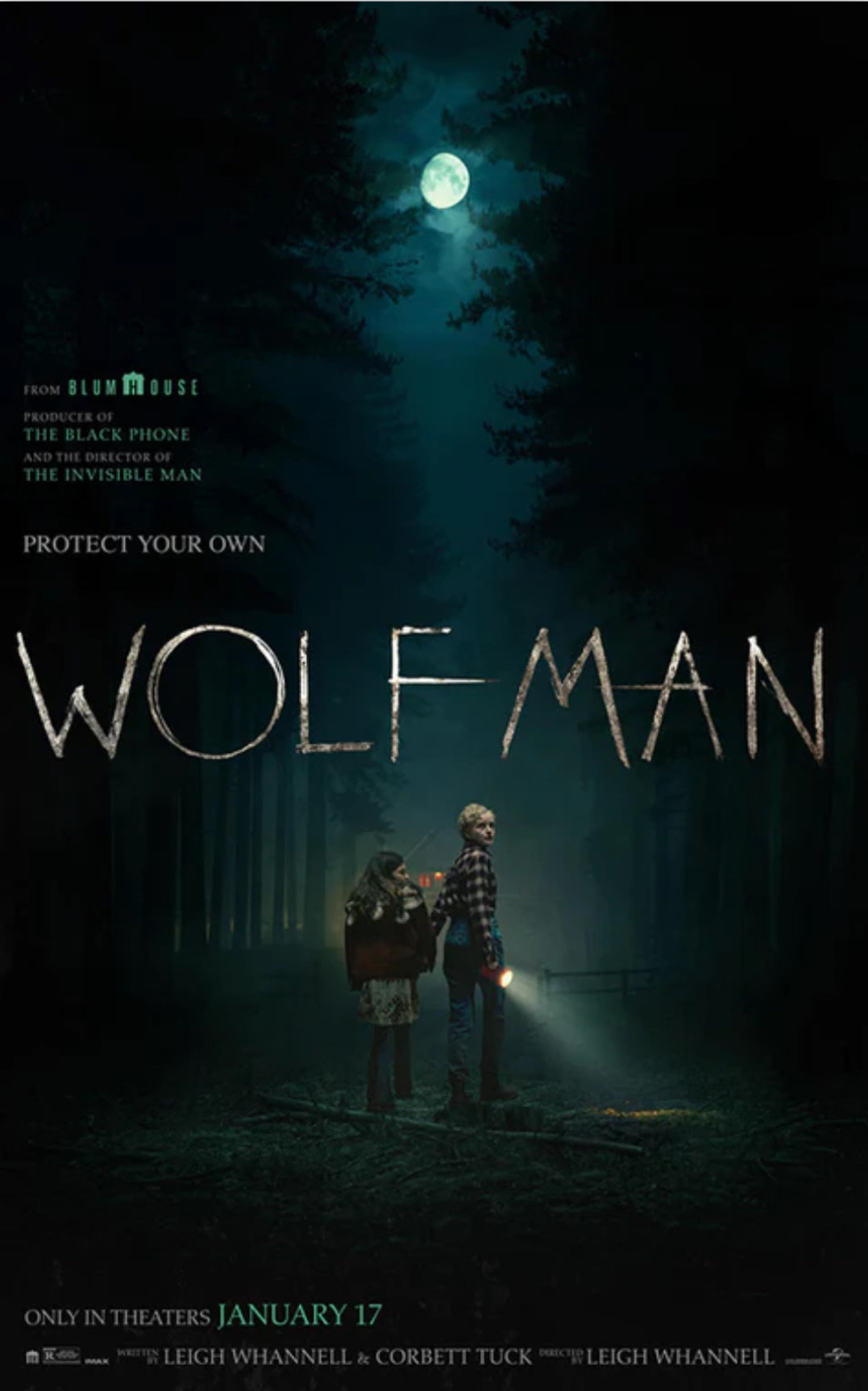
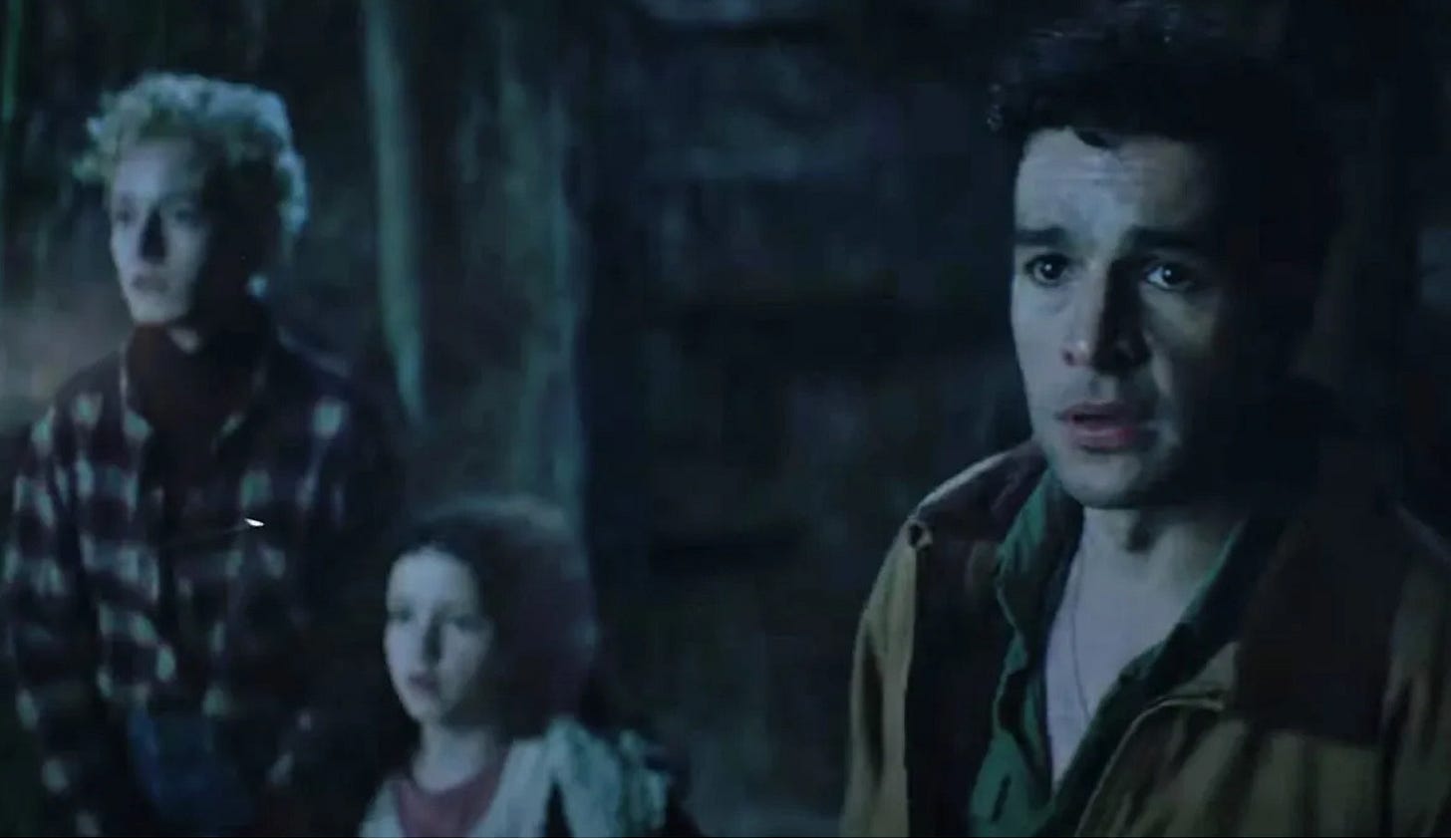
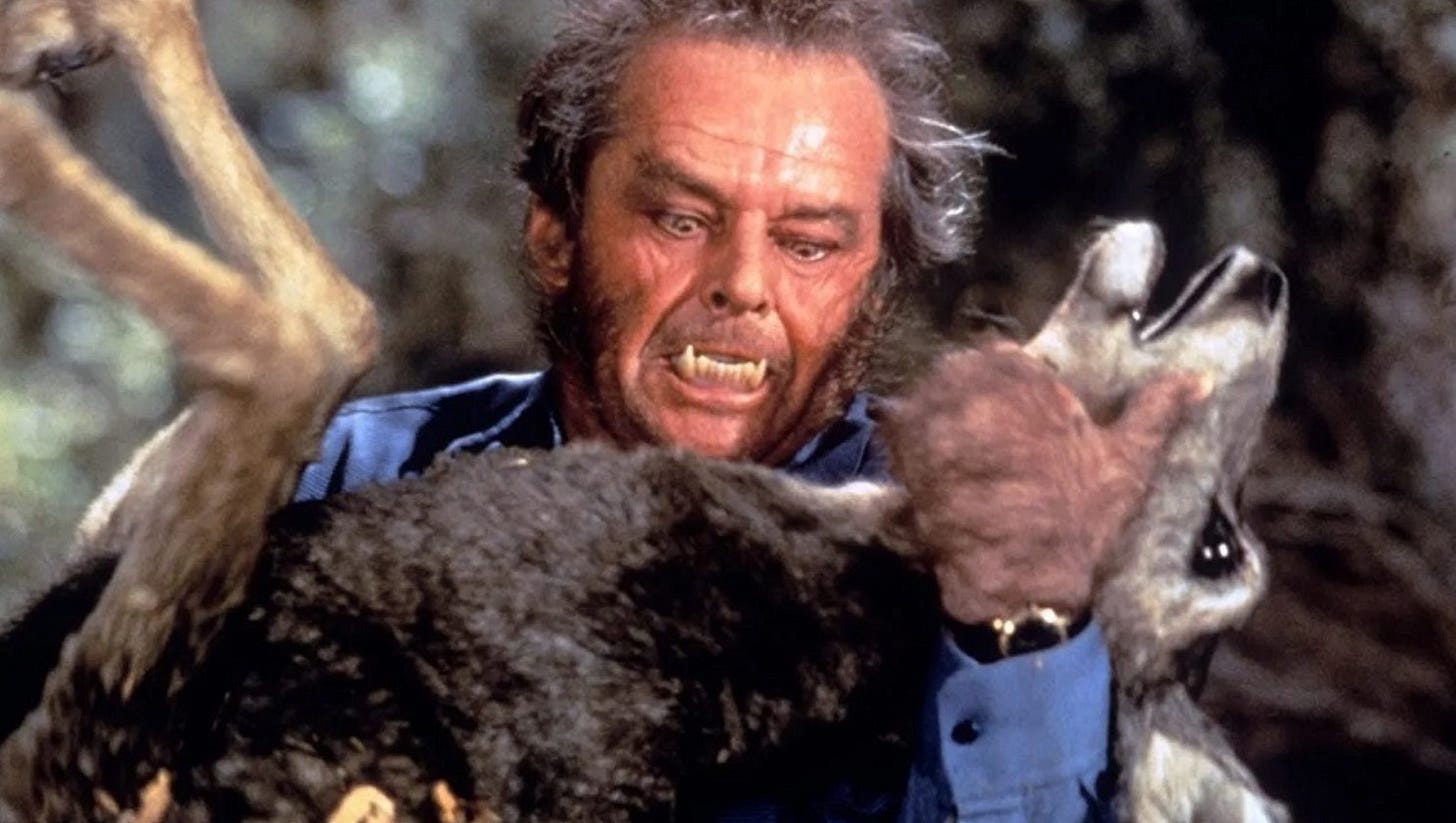
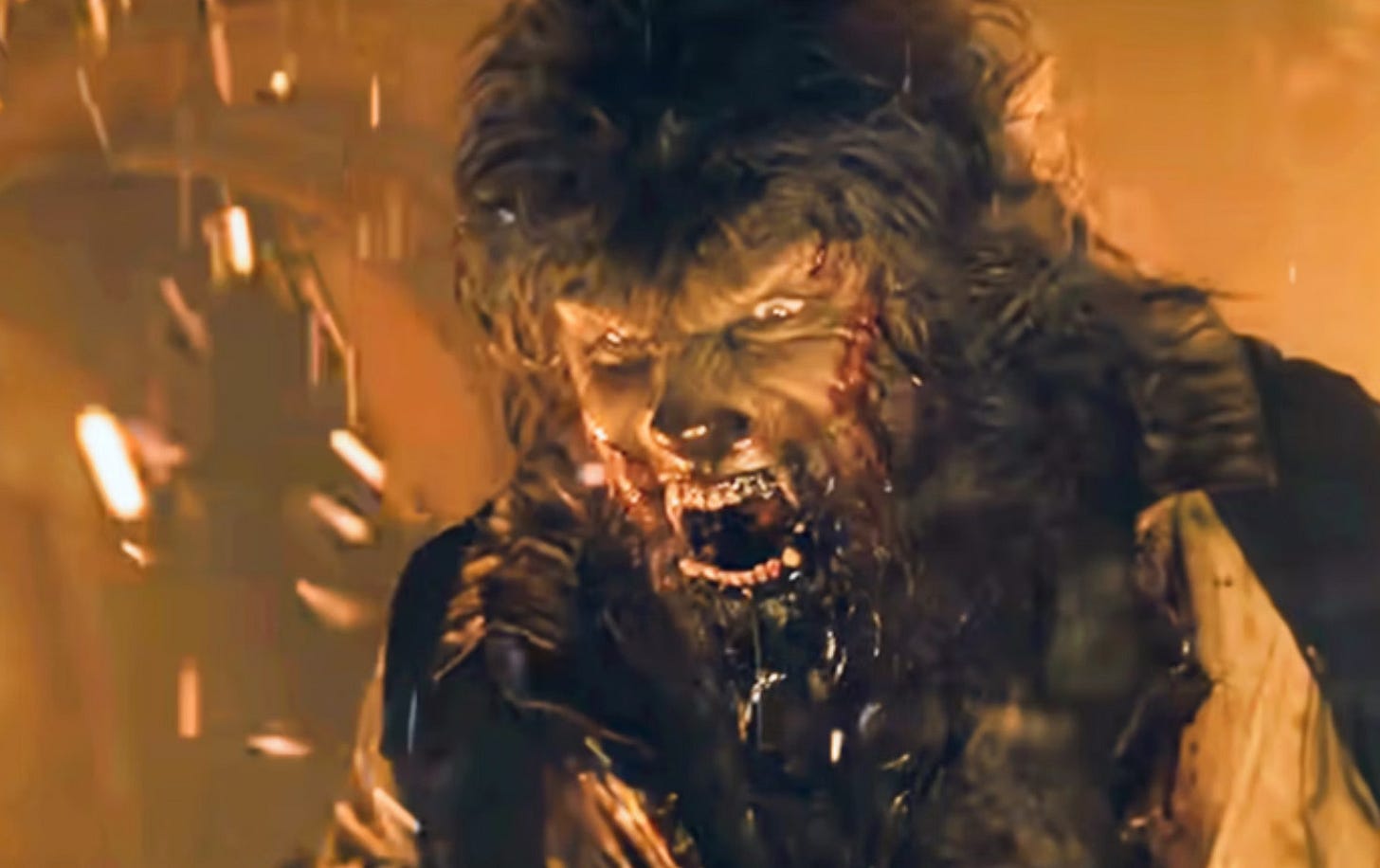

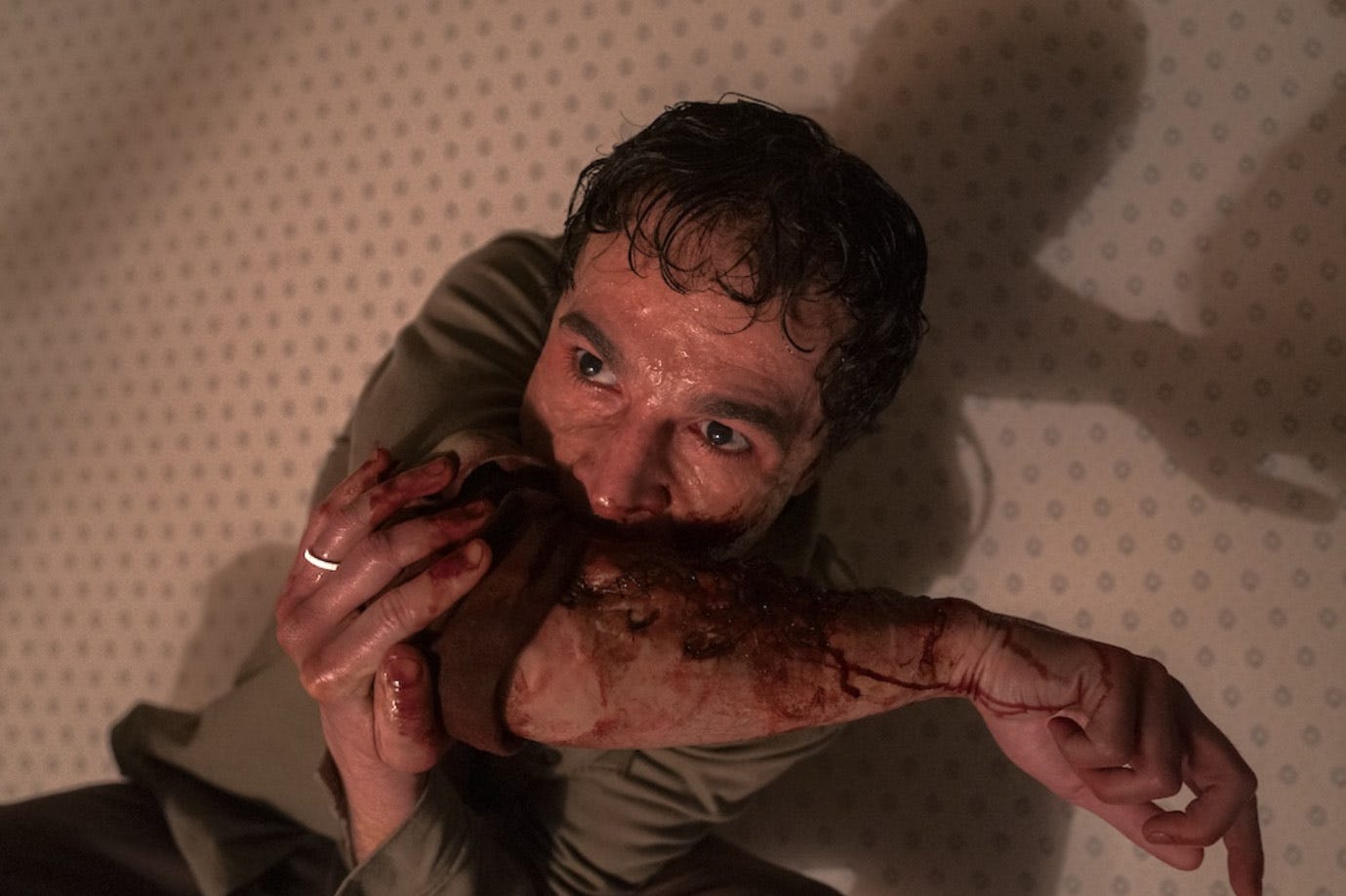

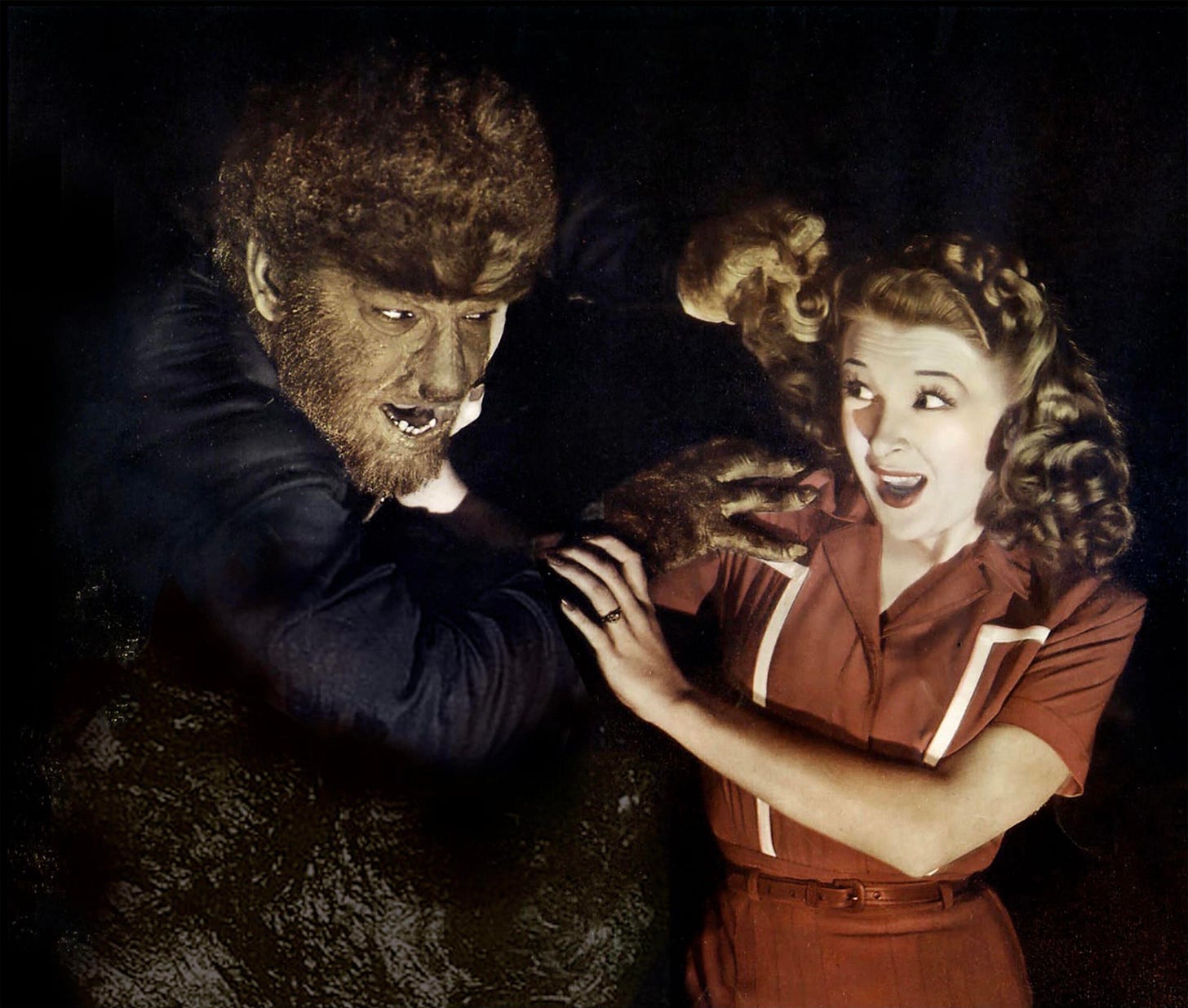
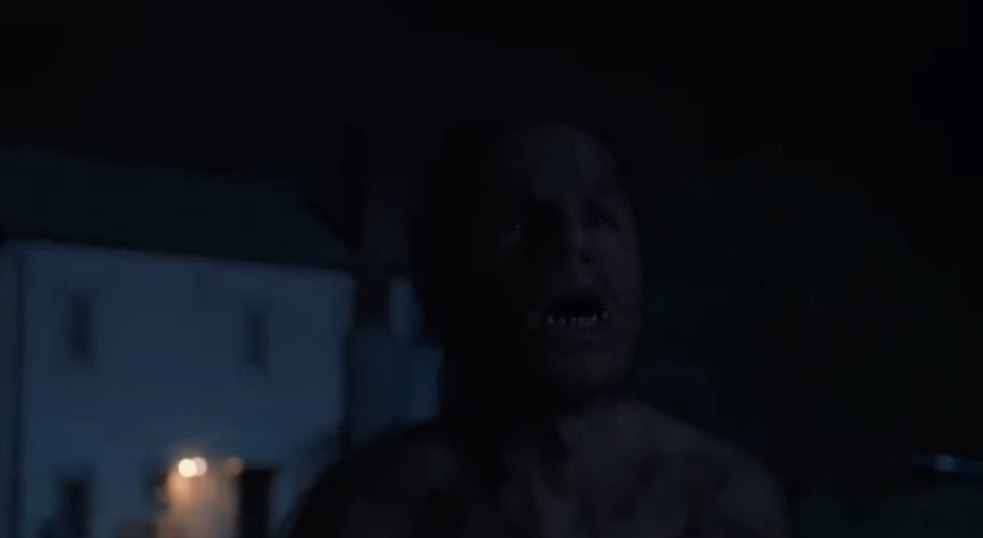
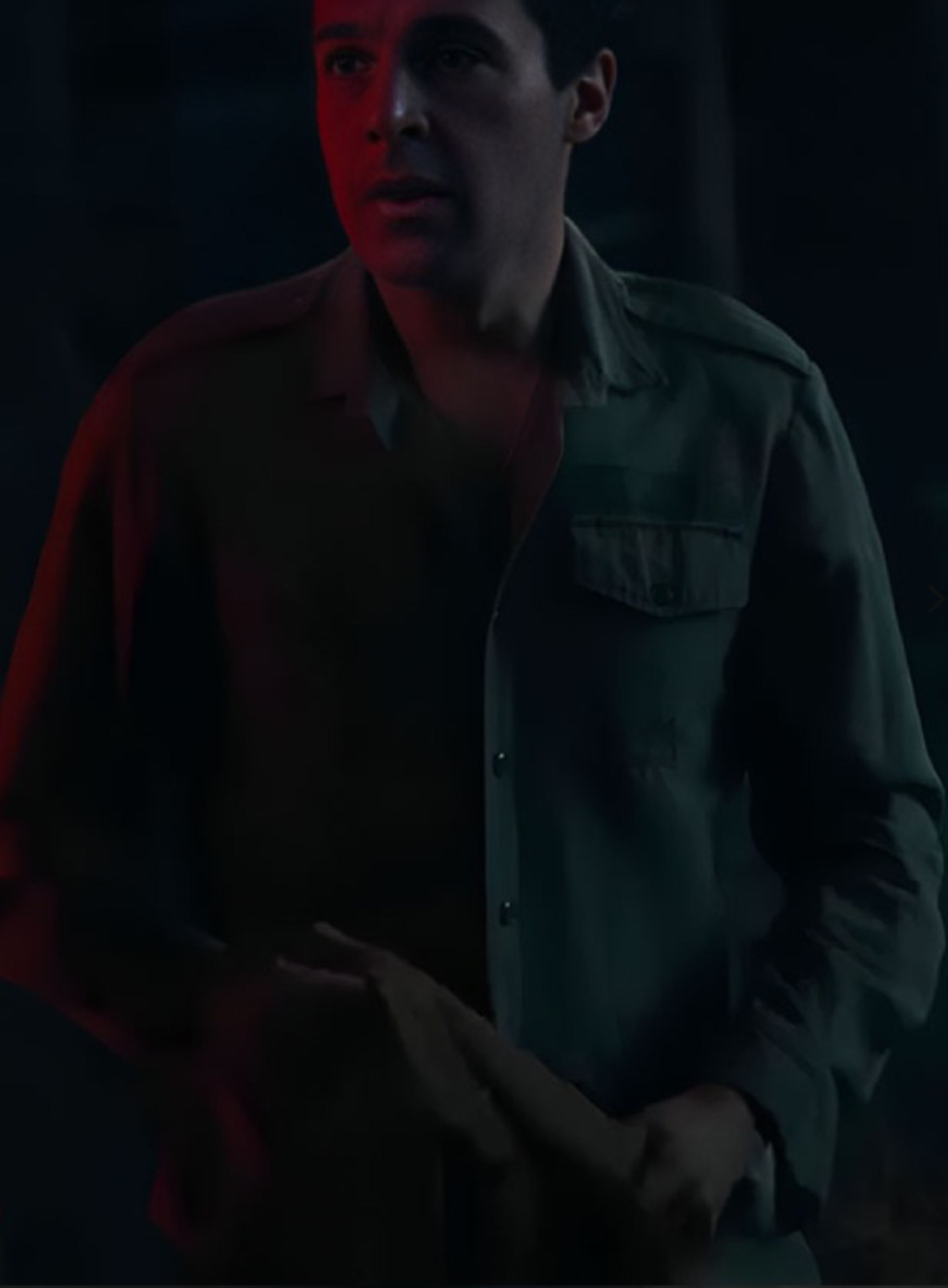
Another egg is the name of the truck company they rent and what crashed is PIERCE trucks which I imagine is a nod to Jack Pierce.